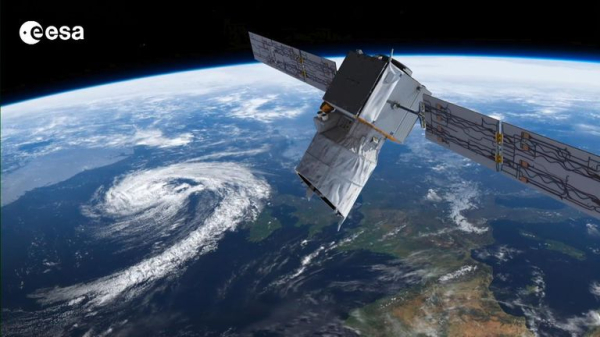British-built satellite Aeolus deliberately crashed into Atlantic in world first

A British-built weather-monitoring satellite has been deliberately crashed into the Atlantic Ocean.
It is the first time a satellite has been guided to perform an assisted crash on Earth, the European Space Agency (ESA) said.
Aeolus has been providing data to weather centres across Europe since 2018, and was the first satellite mission to acquire profiles of Earth’s wind on a global scale.
The 1,360kg craft, built by Airbus Defence and Space in Stevenage, was due to be in orbit for three years but outlasted its mission by almost two more.

Aeolus re-entered Earth’s atmosphere on Friday evening above Antarctica.
The re-entry comes after a series of complex manoeuvres that lowered Aeolus’ orbit from an altitude of 320km (199 miles) to just 120km (74.5 miles) to re-enter the atmosphere and burn up.
This positioned Aeolus so that any pieces that may not have burned up in the atmosphere would fall within the satellite’s planned Atlantic ground tracks.
Under normal circumstances, the satellite would have fallen back to Earth naturally, burning up in the planet’s atmosphere after reaching an altitude of about 80.5km (50 miles).
Instead, it was guided to its final resting place by mission controllers at the ESA, using what little fuel remained onboard.

When Aeolus was designed in the 1990s, there were no regulations requiring space authorities to minimise the risk of causing damage when satellites return to earth.
In the last week, teams of spacecraft engineers, flight dynamics experts and space debris specialists at ESA’s ESOC mission control centre in Germany had planned the difficult manoeuvres for a satellite that was not designed to complete such actions.

ESA’s director of operations, Rolf Densing, said, “The teams have achieved something remarkable. These manoeuvres were complex, and Aeolus was not designed to perform them, and there was always a possibility that this first attempt at an assisted re-entry might not work.
“We have learned a great deal from this success and can potentially apply the same approach for some other satellites at the end of their lives, launched before the current disposal measures were in place.”
YouTube This content is provided by YouTube, which may be using cookies and other technologies. To show you this content, we need your permission to use cookies. You can use the buttons below to amend your preferences to enable YouTube cookies or to allow those cookies just once. You can change your settings at any time via the Privacy Options. Unfortunately we have been unable to verify if you have consented to YouTube cookies. To view this content you can use the button below to allow YouTube cookies for this session only. Enable Cookies Allow Cookies Once
Dr Jenifer Millard, an astronomer and co-host of the Awesome Astronomy Podcast, told Sky News the successful return of Aeolus was a “huge achievement to help us manage space debris”.
About 20% of the craft may have survived re-entry, Dr Millard said, amounting to a few hundred kilogrammes.
It is a boost for the UK space industry, she added.
“We are pioneering, we are world-leading in this,” she said.
Aeolus carried several sophisticated pieces of equipment including an instrument known as ALADIN, which is Europe’s most sophisticated Doppler wind lidar flown in space.
